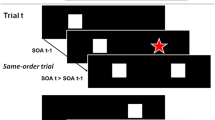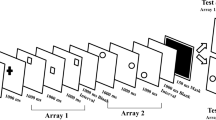Abstract
In previous studies, we provided evidence for a directional distortion of the endpoints of movements to memorized target locations. This distortion was similar to a perceptual distortion in direction discrimination known as the oblique effect so we named it the “motor oblique effect”. In this report we analyzed the directional errors during the evolution of the movement trajectory in memory guided and visually guided pointing movements and compared them with directional errors in a perceptual experiment of arrow pointing. We observed that the motor oblique effect was present in the evolving trajectory of both memory and visually guided reaching movements. In memory guided pointing the motor oblique effect did not disappear during trajectory evolution while in visually guided pointing the motor oblique effect disappeared with decreasing distance from the target and was smaller in magnitude compared to the perceptual oblique effect and the memory motor oblique effect early on after movement initiation. The motor oblique effect in visually guided pointing increased when reaction time was small and disappeared with larger reaction times. The results are best explained using the hypothesis that a low level oblique effect is present for visually guided pointing movements and this effect is corrected by a mechanism that does not depend on visual feedback from the trajectory evolution and might even be completed during movement planning. A second cognitive oblique effect is added in the perceptual estimation of direction and affects the memory guided pointing movements. It is finally argued that the motor oblique effect can be a useful probe for the study of perception–action interaction.





Similar content being viewed by others
References
Aglioti S, DeSouza JFX, Goodale MA (1995) Size-contrast illusions deceive the eye but not the hand. Curr Biol 5:679–685
Appelle S (1972) Perception and discrimination as a function of stimulus orientation: the “oblique effect” in man and animals. Psychol Bull 78:266–278
Bard C, Turrell Y, Fleury M, Teasdale N, Lamarre Y, Martin O (1999) Deafferentation and pointing with visual double-step perturbations. Exp Brain Res 125:410–416
Bridgeman B, Kirch M, Sperling A (1981) Segregation of cognitive and motor aspect of visual function using induced motion. Percept Psychophys 29:336–342
Carey DP (2001) Do action systems resist visual illusions? Trends Cognit Sci 5:109–113
Desmurget M, Epstein CM, Turner RS, Prablanc C, Alexander GE, Grafton ST (1999) Role of the posterior parietal cortex in updating reaching movements to a visual target. Nat Neurosci 2:563–567
Desmurget M, Grafton S (2000) Forward modelling allows feedback control for fast reaching movements. Trends Cognit Sci 4:423–431
Dyde RT, Milner AD (2002) Two illusions of perceived orientation: one fools all people some of the time; the other fools all of the people all the time. Exp Brain Res 144:518–527
Elliott D, Helsen WF, Chua R (2001) A century later: Woodworth’s (1899) two-component model of goal directed aiming. Psychol Bull 27:342–357
Elliott D, Madalena J (1987) The influence of premovement visual information on manual aiming. Q J Exp Psychol A 39:541–559
Essock EA (1980) The oblique effect of stimulus identification considered with respect to two classes of oblique effects. Perception 9:37–46
Franz VH (2001) Action does not resist visual illusions. Trends Cogn Sci 5:457–459
Gaveau V, Desmurget M (2004) Do movement planning and control represent independent modules? Behav Brain Sci 27:35–36
Gentaz E, Hatwell Y (1995) The haptic “oblique effect” in children’s and adults’ perception of orientation. Perception 24:631–646
Gentilucci M, Chieffi S, Daprati E, Saeti MC, Toni I (1996) Visual illusion and action. Neuropsychologia 34:369–376
Glover S (2004) Separate visual representations in the planning and control of actions. Behav Brain Sci 27:3–78
Glover S, Dixon P (2001) Dynamic illusion effects in a reaching task: evidence for separate visual representations in the planning and control of reaching. J Exp Psychol Hum Percept Perform 27:560–572
Goodale MA, Milner AD (1992) Separate visual pathways for perception and action. Trends Neurosci 15:20–25
Goodale MA, Pelisson D, Prablanc C (1986) Large adjustments in visually guided reaching do not depend on vision of the hand or perception of target displacement. Nature 320:748–750
Goodale MA, Westwood DA (2004) An evolving view of duplex vision: separate but interacting cortical pathways for perception and action. Curr Opin Neurobiol 14:203–211
Gourtzelidis P, Smyrnis N, Evdokimidis I, Balogh A (2001) Systematic errors of planar arm movements provide evidence for space categorization of multiple frames of reference. Exp Brain Res 139:59–69
Hu Y, Goodale MA (2000) Grasping after a delay shifts size-scalling from absolute to relative metrics. J Cogn Neurosci 12:856–868
Krukowski AE, Stone LS (2005) Expansion of direction space around the cardinal axes revealed by smooth pursuit eye movements. Neuron 45:315–323
Milner DA, Dyde RT (2003) Orientation and disorientation: illusory perception and the real world. In: Johnson-Frey SH (eds) Taking action cognitive neuroscience perspectives on intentional acts. Bradford Book, MIT Press, Cambridge, MA, London, England, pp 4–28
Prablanc C, Martin O (1992) Automatic control during hand reaching at undetected two-dimensional target displacements. J Neurophysiol 67:455–469
Smyrnis N, Gourtzelidis P, Evdokimidis I (2000) Systematic directional error in 2-D arm movements increases with increasing delay between visual target presentation and movement execution. Exp Brain Res 131:111–120
Smyrnis N, Mantas A, Evdokimidis I (2007) The “motor oblique effect”: perceptual direction discrimination and pointing to memorized visual targets share the same preference for cardinal orientations. J Neurophysiol 97:1068–1077
van Donkelaar P (1999) Pointing movements are affected by size-contrast illusions. Exp Brain Res 125:517–520
van Sonderen JF, Denier van der Gon JJ, Gielen CCAM (1988) Conditions determining early modification of motor programmes in response to changes in target location. Exp Brain Res 71:320–328
Wolpert DM, Ghahramani Z, Jordan MI (1995) An internal model for sensorimotor integration. Science 269:1880–1882
Acknowledgments
This work was partly supported by the “Kapodistrias 2004-2005” program for research support from the National and Kapodistrian University of Athens.
Author information
Authors and Affiliations
Corresponding author
Rights and permissions
About this article
Cite this article
Mantas, A., Evdokimidis, I. & Smyrnis, N. Perception action interaction: the oblique effect in the evolving trajectory of arm pointing movements. Exp Brain Res 184, 605–616 (2008). https://doi.org/10.1007/s00221-007-1255-y
Received:
Accepted:
Published:
Issue Date:
DOI: https://doi.org/10.1007/s00221-007-1255-y




